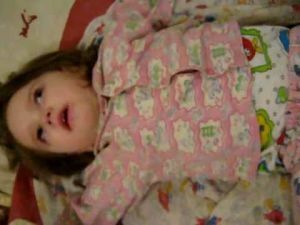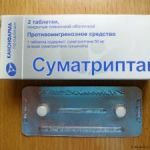 This form of epilepsy, also called infantile spasms, often appears in 4 to 6 months of life. Boys are sick more often than girls.
This form of epilepsy, also called infantile spasms, often appears in 4 to 6 months of life. Boys are sick more often than girls.
During the attack, the body tilts forward quickly, the head bends. Seizures appear when the baby falls asleep, or before awakening. The frequency of attacks can reach hundreds of days.
Causes that cause Vesta
Syndrome The most common cause of the syndrome is hypoxic brain damage to the child's during difficult births.
The causes of the Vesta syndrome are as follows:
- congenital malformations of the brain;
- various genetic diseases;
- asphyxiation;
- in premature infants - hemorrhage within the skull.

In the picture a child with Vest syndrome
It happens that the cause of this illness can not be determined. In such cases it is necessary to talk about the idiopathic form of the syndrome.
Patients with clinical signs without changes in the encephalogram or patients without symptoms, but with changes to the EEG, refer to the
first risk group .They do not need treatment, but an annual examination is necessary.Patients in the second group of have mild clinical and EEG signs.
They undergo treatment and should be examined twice a year. To , the third group of is considered to include patients with bright clinical and electroencephalographic manifestations.
Symptoms and Symptoms
Vest syndrome has such signs:
- frequent, especially not treatable epileptic seizures;
- gypsarhythm - standard for EEG syndrome;
- psychomotor development disorder.
In 90% of children with this disorder, seizures begin in the first year of life, most often in the range of 3 to 8 months.
In the beginning, doctors determine colic, tk.signs and crying, which the child publishes during and after a fit, are very similar to colic.
The standard features of are:
- body slopes forward;
- cramps of the body, arms and legs;
- arms and legs can be bred to the sides to the same extent for the right and left side of the body.
Most often, each attack lasts one or two seconds, then there comes a short pause, after which the next spasm sets in. On the video you can see how Vest syndrome manifests itself in a small child.
While babies may have spasms, infantile seizures usually follow a series of several spasms in a row.
Children with this disorder are characterized by irritability, inhibition of development and even degradation, which do not disappear without treatment. Such babies can also behave as if they do not see.
Health status is normalized when the disease is treated and EEG data is improved.
Therapeutic procedures
The main methods of treatment are the prescription of steroid preparations or vigabatrin .
Steroids should be taken carefully, because they lead to unpleasant side effects. Vigabatrin also has a similar property.
A neurosurgeon can perform an operation to dissect the brains of the meninges, remove the brain tumor and congenital aneurysms of the vessels. A high-precision intervention technique is used by means of stereotaxic surgery, sparing endoscopic methods.
 Good results were obtained with the treatment of Vesta syndrome by stem cells. The method is still new and yet expensive, but clearly promising.
Good results were obtained with the treatment of Vesta syndrome by stem cells. The method is still new and yet expensive, but clearly promising.
The essence of the treatment consists in the restoration of the impaired part of the brain by means of basic stem cells, which are the basis for any tissue, even for the nervous one.
To treat the idiopathic form of the disorder, medicinal preparations are used:
- anticonvulsants( nitrazepam, epilim);
- hormonal and steroid preparations( prednisolone, hydrocortisone, tetracosactide);
- vitamin therapy - a large dose of vitamin B6( pyridoxine).
The effectiveness of treatment is determined by how fast seizures disappear and their severity declines. If the medicine is selected competently and its dose is sufficient, then the child begins to develop correctly and learn in the future, to lead a full life.
Unfortunately, the drugs do not always give an effect and even the newest ones.
It should also be noted that the drugs have side effect:
- feeling of constant fatigue;
- concentration disorder;
- skin and endocrine reactions;
- depression;
- peripheral nerve damage;
- deviations in the work of the liver.
The more used dose, the more pronounced side effects.
In the situation with the symptomatic form of the disease, the forecast remains quite heavy today.
 We select the most effective triptans from migraine and we study the specificity of the action of drugs on the body.
We select the most effective triptans from migraine and we study the specificity of the action of drugs on the body.
Should I take Algeric's medication - instructions for use, reviews and other useful information about the drug.
Prognosis, Mortality and Lifetime in Vesta
Syndrome It is impossible to predict the overall prognosis of development due to various causes, as well as various symptoms. Each case must be analyzed separately.
Prognosis for infants with idiopathic syndrome Vesta is more optimistic for than for symptomatic forms.
In the case of idiopathic syndrome, there is a less severe delay in development before the onset of seizures, and the cramps themselves are easier to treat. Children with this form often undergo transformation into other forms of epilepsy and about 40% of children do not differ from healthy ones.
In other cases, the treatment of the syndrome has difficulties, and the results are unsatisfactory, for children with symptomatic forms, the forecast is negative, especially if immunity to medicines is revealed.
According to the Vesta syndrome, the life expectancy of is 5% of children with impaired do not survive to 5 years, in some cases due to illness, in some cases due to complications of treatment.
Less than 50% achieve remission with medications. Statistics prove that only 30% of cases are treated normally, and only every 25th child has a relatively normal level of physical and mental development.
Up to , 90% of toddlers suffer from a delay in the physical or mental development of , even with successful treatment of seizures. Often this relates not to seizures themselves, but to the reasons underlying their development. Severe persistent seizures can themselves become a factor in brain damage. 
Permanent brain damage associated with Vest syndrome includes cognitive impairment, learning difficulties, behavioral abnormalities, paralysis, mental abnormalities and autism.
About 60% of children with the syndrome suffer from epilepsy later in life. Sometimes the violation is transformed into other forms. Approximately half of all cases become Lennox-Gastaut syndrome.
A fifth of sick children die before the year. The cause of death is congenital pathology of brain development. Of the survivors, three-quarters suffer from abnormalities in psychomotor development.
It is extremely important to diagnose Vest syndrome in time and immediately begin appropriate treatment. The earlier the treatment is started, the more likely a positive outcome of the disease.
With the correct selection of antiepileptic drugs in half the cases it turns out to achieve an absolute cure of the child from seizures.
Late diagnosis and improper selection of drugs lead to a loss of precious time and worsen the prognosis of the disease.



